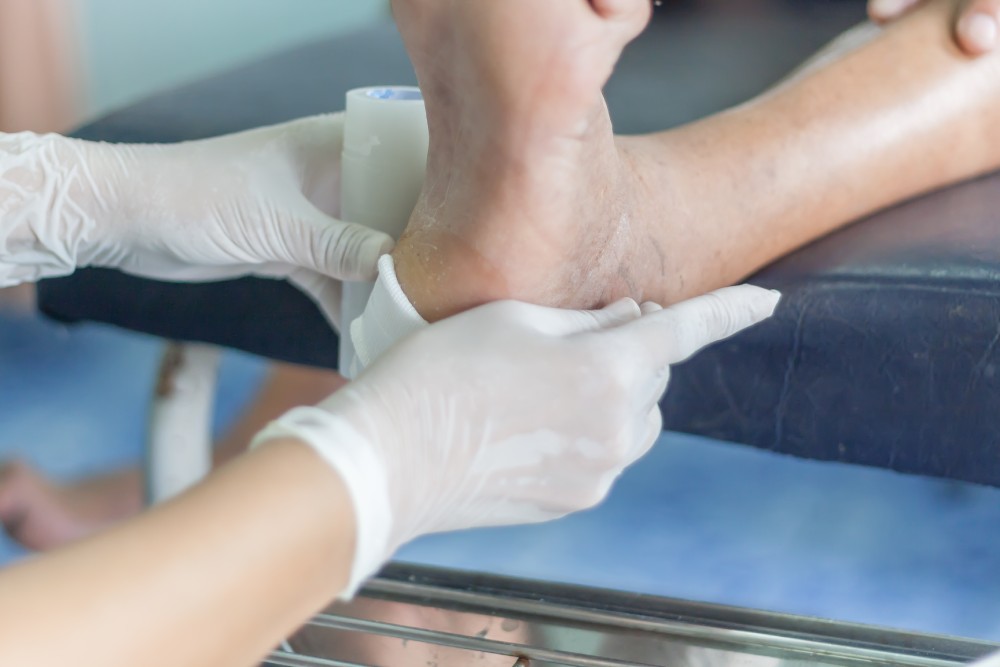Ulcer wounds are one of the most difficult wounds to heal. Unlike small cuts or scratches, they often come back again and again if not treated properly. Many patients in India live with pain, infection, and discomfort because they do not get the right advice at the right time. At Wound Guide – India’s First Wound Care Helpline, we have seen how ulcer wounds affect daily life and why proper treatment under medical supervision is so important.
In this blog, we will explain three common types of ulcer wounds— diabetic foot ulcers, pressure sores, and venous ulcers. We will also share how doctors usually treat them and how you can take better care at home with the right guidance.
Diabetic Foot Ulcers
People living with diabetes are more likely to develop foot ulcers. This happens because high blood sugar can damage nerves and reduce blood flow in the feet. When a small cut, blister, or injury occurs, the patient may not feel it, and the wound can slowly turn into an ulcer.
Doctors begin treatment by checking the early stage diabetic foot ulcer. They clean the wound carefully to remove dirt and dead skin. This is one of the first steps when learning how to clean an infected wound safely. Doctors may use special dressings to keep the wound moist, which helps in faster healing.
Another important part of treatment is offloading, which means reducing pressure on the wound by using special footwear or crutches. In some cases, medicines to fight infection or even surgery to improve blood circulation may be required.
At Wound Guide, we guide patients and families on simple practices for foot care, including how to check feet daily, maintain blood sugar levels, and seek immediate help if there is swelling, redness or pus.
Pressure Sores (Bedsores)
Pressure sores, also called bedsores, happen when a person is lying in one position for too long. This is common among elderly or bedridden patients. The skin and tissue under pressure start to break down and form wounds.
Doctors treat pressure sores based on the stage of the wound. In the early stage, they recommend regularly changing the patient’s position and using soft cushions or mattresses to reduce pressure. Good skin cleaning and moisture control are also important. If the wound is infected, dressings and antibiotics may be needed.
Families should also know about the risk factors for developing pressure ulcers, such as immobility, poor nutrition, dehydration and uncontrolled medical conditions. By reducing these risk factors, the chances of sores becoming severe are much lower.
At Wound Guide, we support caregivers by teaching them simple daily routines for turning patients, keeping the skin clean, and recognising warning signs early.
Venous Ulcers
Venous ulcers usually occur in the lower legs due to poor blood circulation in the veins. When blood does not flow back properly, it collects in the legs and causes swelling, dark skin and wounds that do not heal easily.
Doctors treat venous ulcers mainly through compression therapy, which involves special bandages or stockings that improve blood flow. Proper cleaning and dressing of the wound are also done to prevent infection. Sometimes, procedures to improve vein function may be recommended.
Patients and families often get confused between different types of ulcers, which is why it helps to understand venous vs arterial ulcers. Venous ulcers are caused by weak veins, while arterial ulcers happen due to poor blood supply from blocked arteries. Doctors check the blood circulation first before starting the right treatment.
At Wound Guide, we explain these differences in simple words so that patients know why their wound is not healing and what treatment plan is needed.
Caring for Ulcer Wounds at Home
While doctors play the main role in treating ulcer wounds, home care is equally important. Many patients try local remedies or ignore small signs until the wound gets worse. This can lead to serious infection and even long hospital stays.
For safe home care, it is important to know about infected wound care at home. This includes washing hands before touching the wound, using clean dressings, avoiding harsh chemicals, and seeking medical help if there is foul smell, swelling, or increased pain. Families should also learn how to disinfect an infected wound correctly, because using the wrong methods can harm the skin further.
In some cases, patients suffer from chronic non-healing wounds that do not improve even after weeks of treatment. At this stage, advanced therapies like skin grafting, negative pressure wound therapy, or vascular surgery may be suggested by doctors.
At Wound Guide, we provide personalized guidance on these issues through our helpline so patients do not feel alone in their journey of healing.
Why Wound Guide?
What makes Wound Guide different is our focus on patient-friendly support. Many people are unaware of proper ulcer wound care and do not know whom to approach. As India’s First Wound Care Helpline, we connect patients and caregivers to reliable information, expert guidance and practical steps that actually work.
We believe that no wound should be ignored and every patient deserves the chance to heal with dignity.
Final Thoughts
Ulcer wounds can be painful, frustrating and even dangerous if ignored. But with timely medical treatment, proper home care and the right guidance, they can be managed effectively. Doctors focus on cleaning, infection control, improving circulation and reducing pressure. Families must support healing through good nutrition, hygiene and regular monitoring.
If you or your loved one is suffering from a diabetic foot ulcer, pressure sore, or venous ulcer, remember that help is available. The Wound Guide Wound Care Helpline is here to provide trusted advice and compassionate support so that healing becomes possible.





Comments